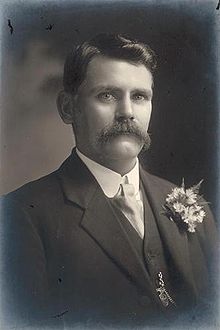| Richard Buzacott | |
|---|---|
 | |
| Senator for Western Australia | |
| In office 1 July 1910 – 30 June 1923 | |
| Personal details | |
| Born | (1867-09-07)7 September 1867 Clare, South Australia |
| Died | 10 January 1933(1933-01-10) (aged 65) Balwyn, Victoria |
| Political party | Labor (1910–17) Nationalist (1917–23) |
| Spouse | Mary Lucy Marshall |
| Occupation | Miner |
Richard Buzacott (7 September 1867 – 10 January 1933), Australian politician, was a Member of the Australian Senate from 1910 to 1923.
Commonly known as Dick Buzacott, he was born at Emu Flat, Clare, South Australia on 7 September 1867. The son of a farmer of the same name, he was educated at Stanley Flat Primary School, and Clare High School, then worked as an agricultural labourer. From 1891 to 1898 he was a miner at Broken Hill, New South Wales, and from 1899 to 1900 he was in Queensland.
In 1900 Buzacott migrated to the Western Australian goldfields, mining on the Goongarrie fields near Menzies. He became active in the Labor movement, becoming president of the Menzies branch of the Amalgamated Workers' Union in 1901, and of the Amalgamated Miners' Association in 1903. From 1904 he was President of the Australian Labor Federation. In the elections of 28 June 1904 and 27 October 1905, he contested the Western Australian Legislative Assembly seat of Menzies as a Labor candidate, but was defeated on both occasions by the incumbent Henry Gregory. From 1906 to 1907 he was secretary of the Menzies Miners' Institute.
On 31 March 1908, Richard Buzacott married Mary Lucy Marshall. They had one son, Richard Norman Buzacott.
On 11 September 1908, Buzacott defeated Gregory for the seat of Menzies in a general election. Gregory then disputed the result with the Court of Disputed Returns, retaining his seat while the matter was under its consideration. Ultimately, the election was declared void, and a by-election was held on 20 November, which Gregory won by 56 votes.
On 13 April 1910, Buzacott was elected to the Australian Senate on a Labor ticket. He took his seat on 1 July, serving as a Labor member until the conscription crisis of 1917, when he was expelled from the party as a pro-conscriptionist, and joined the Nationalists. Over the next five years he served as a member of the Federal Parliamentary Recruiting Committee to Inquire into the Effect of Liquor on Australian Soldiers (1917–18); the Joint Committee of Public Accounts (1920–22); and the Royal Commission on War Service Homes (1922). He retained his seat until 30 June 1923, having lost it in the election of 14 December the previous year.
Buzacott lived in Melbourne from around 1912. Very little is known of his life after politics.
His wife died on 10 January 1976 aged 88, and he had pre-deceased her at Balwyn, Victoria, on 10 January 1933 aged 65.
One of Richard Buzacott's brothers Nicholas was a Member of the New South Wales Legislative Council from 1899 to 1933. Another brother, Roderick Buzacott was a major South Australian Farm Implement Manufacturer in the town of Blyth, located near Clare, where they were born and raised.Another brother, Alexander Herbert Stanley Buzacott also went to Western Australia (Kalgoolie and then Perth)- some of his descendants have now returned to Adelaide, South Australia
References
- ^ Bolton, Geoffrey. "BUZACOTT, Richard (1867–1933)". The Biographical Dictionary of the Australian Senate. Retrieved 21 December 2022.
- "The Menzies Election". Western Mail. 28 November 1908. p. 33. Retrieved 22 December 2022 – via Trove.
- "Mr Nicholas James Buzacott (1866-1933)". Former members of the Parliament of New South Wales. Retrieved 5 May 2019.
- Black, David; Bolton, Geoffrey (2001). Biographical Register of Members of the Parliament of Western Australia, Volume One, 1870–1930 (Revised ed.). Parliament House: Parliament of Western Australia. ISBN 0730738140.
- 1867 births
- 1933 deaths
- Australian Labor Party members of the Parliament of Australia
- Nationalist Party of Australia members of the Parliament of Australia
- Members of the Australian Senate
- Members of the Australian Senate for Western Australia
- People from Clare, South Australia
- Australian miners
- National Labor Party members of the Parliament of Australia